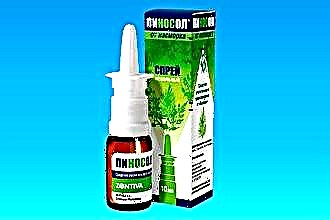There are many sinusitis. They differ according to a number of criteria: the type of pathogen, symptoms, the form of the course, and so on. Many people confuse the symptoms of this disease with a common or allergic rhinitis (by the way, it is similar to serous sinusitis). This confusion is precisely the main danger. After all, a person thinks that he just has a runny nose, and at this time the inflammation of the maxillary sinuses is aggravated. Due to ignorance, the patient turns to the doctor with an already advanced chronic disease (for example, with hyperplastic sinusitis).
To avoid complications, you need to know the types of sinusitis, their signs and at least approximately imagine how to treat this disease.
Classification of sinusitis
Sinus inflammation is usually classified according to several main criteria. Otolaryngologists distinguish the following types of sinusitis:
 By the prevalence of the pathological process:
By the prevalence of the pathological process:
- 1-sided - when only one sinus is inflamed - left or right;
- 2-sided - diagnosed when both sinuses are involved in the inflammatory process.
By type of pathogen:
- Viral. Usually he does not reveal himself to anything. It proceeds against the background of ARVI. Disappears on its own after 2-3 weeks, provided adequate antiviral treatment.
- Bacterial. Appears on the 7-14th day of the development of an acute form of the common cold. The reason is the addition of a bacterial infection against the background of reduced immunity.
- Allergic. It develops as a result of the detrimental effect of any allergen on the mucous membrane.
- Fungal. Often occurs with reduced immunity, as well as if a person takes antibiotics too often and unnecessarily.
- Traumatic. A prerequisite is a head injury, especially if the anterior wall of the maxillary sinus is broken.
- Aerosinusitis. It can develop during air travel, as well as during sudden pressure surges (it happens mainly among scuba divers and divers).
- Mixed. When there are several types of disease at once.
- By the nature of the course of the disease:
- Spicy. Its characteristic feature is seasonality with an increased risk of getting sick in the spring and autumn. The duration of this form of the disease is approximately 3-4 weeks.
- Chronic. With this form of the course of the disease, exacerbations are replaced by absolutely asymptomatic remissions.
By clinical manifestations:
- Catarrhal (the most striking symptom is swelling; purulent discharge is absent).
- Purulent (easily recognized by secretions with purulent contents).
 Hyperplastic (due to the growing mucosa, the cavity of the maxillary sinus narrows and, accordingly, the diameter of the outlet opening).
Hyperplastic (due to the growing mucosa, the cavity of the maxillary sinus narrows and, accordingly, the diameter of the outlet opening).- Allergic (an allergen triggers the process of inflammation).
- Polypous (as a result of the growth of the altered mucosa, polyps appear; usually this type is preceded by hypertrophic sinusitis).
- Atrophic (due to disruption of the mucous glands, the production of mucus decreases or completely stops - the mucous membrane dries up).
- Mixed (when several forms of the disease are present at once).
Now let's look at each category separately and in more detail.
By type of pathogen
In accordance with the specific type of pathogen, otolaryngologists divide sinusitis into several varieties. This criterion is very important for correct diagnosis. It is he who underlies the development of a treatment strategy for this disease.
- Viral. The background for its development is a banal cold. The inflammatory process affects all the mucous membranes that line the respiratory tract. The maxillary sinuses are, of course, no exception. Discharge from the nasal passages is transparent, does not contain impurities of blood and pus. If sinusitis is provoked by a virus, its main symptom is swelling. In this case, special treatment is not required, since the disease goes away on its own within a month. If immunity is reduced, the risk that a bacterial infection will also cling increases. Then there will be a need for serious therapeutic measures.
 Bacterial. It appears as a result of the occupation of the mucous membrane by harmful bacteria - staphylococci, streptococci and pneumococci. This happens, as a rule, against the background of a decrease in immunity. The color of the nasal discharge (yellowish to dark green) can indicate a specific type of microorganism. In addition, this type of sinusitis can develop if foreign bodies enter the paranasal sinuses. In most cases, this is observed in babies. Due to their curiosity, a wide variety of objects appear in the nose. And both edible and household. Pathogens can enter the sinuses if something festers in the mouth. Periodontitis of the upper jaw is especially dangerous. Indeed, in this case, the focus of inflammation is located very close to the sinuses. If infection does occur, such sinusitis is called odontogenic.
Bacterial. It appears as a result of the occupation of the mucous membrane by harmful bacteria - staphylococci, streptococci and pneumococci. This happens, as a rule, against the background of a decrease in immunity. The color of the nasal discharge (yellowish to dark green) can indicate a specific type of microorganism. In addition, this type of sinusitis can develop if foreign bodies enter the paranasal sinuses. In most cases, this is observed in babies. Due to their curiosity, a wide variety of objects appear in the nose. And both edible and household. Pathogens can enter the sinuses if something festers in the mouth. Periodontitis of the upper jaw is especially dangerous. Indeed, in this case, the focus of inflammation is located very close to the sinuses. If infection does occur, such sinusitis is called odontogenic.- Fungal. It develops due to too frequent and irrational use of antibacterial drugs, with serious immunodeficiency, in old age and with prolonged treatment with synthetic hormones of any ailment. These factors contribute to the excessive multiplication of fungi (moldy and yeast) on mucous membranes throughout the body. When these fungi encounter viruses or are exposed to unfavorable conditions, inflammation and swelling occur.
- Traumatic. It appears as a result of serious trauma to the skull, especially if the anterior nasal septum is affected. Due to heavy bleeding, clots of clotted blood can enter the maxillary sinuses. If this type of sinusitis is not recognized in time, the risk of the addition of viral and fungal infections, as well as the development of suppuration in the sinuses of the upper jaw, significantly increases.
- Aerosinusitis provokes significant jumps in blood pressure with an unsatisfactory condition of the mucous membranes (for example, after a recent cold). A sharp drop in pressure causes injury to the mucous membrane, as a result of which it becomes inflamed. The symptomatology for this type of sinusitis is the same as for its other types.
By the nature of the course of the disease
Sinusitis has only two forms: acute and chronic. The differences between these forms are in the symptoms, the duration of the course of the disease and in the consequences for the whole organism as a whole.
The acute form usually occurs as a result of a complication of a cold. Its duration is no more than a month. It manifests itself:
 general unimportant well-being;
general unimportant well-being;- high rates of body temperature;
- a feeling of chills;
- headache attacks.
In the acute form of the disease, tilting the head forward is accompanied by increased pain. The reason for this symptom is that the pressure on the front wall of the inflamed sinus increases. You may also experience increased lacrimation and even photophobia.
Breathing through your nose is either extremely difficult or not possible at all. Severe congestion interferes. Also disturbed by abundant mucous or purulent discharge from the nasal passages. In some cases, the ability to distinguish odors disappears, the eyelids swell and the cheeks swell.
Treatment of sinusitis in an acute form is usually conservative: the doctor prescribes anti-inflammatory drugs and medicines to reduce swelling, prescribes washing the nose and sinuses. Independently, it is permissible to use only proven "grandmother's" recipes.Any warming up is strictly prohibited.
Chronic sinusitis is a sluggish form of the disease. Its duration is more than 2 months. It is characterized by rapidly approaching fatigue, general weakness, and poor health. In the evenings, nasal congestion and headache attacks may become more pronounced.
If inflammation is not stopped in a timely manner, it can cause serious complications. Chronic sinusitis can be complicated by:
- purulent or serous meningitis;
- swelling of the lining of the brain;
- brain abscess;
- edema of the orbital tissue;
- venous thrombosis.
Proceeding from the fact that the patient's condition with this form of sinusitis is, in principle, satisfactory, the therapeutic course is supplemented with inhalation, physiotherapy and heating (only dry heat).
It should be borne in mind that the treatment of chronic sinusitis is longer than acute.
By clinical manifestations
The types of sinusitis can be distinguished based on their clinical symptoms and the degree of damage to the mucous membrane lining the paranasal sinuses.
 Catarrhal. Usually complements the common cold. This type of disease, as a rule, proceeds in an acute form. It is accompanied by pronounced swelling of the sinuses, swelling and irritation of the mucous membrane, which can almost completely occupy their volume. In addition, there is a large amount of clear mucus from the nasal passages. If catarrhal sinusitis is not treated, edema can spread to nearby organs and provoke, for example, otitis media.
Catarrhal. Usually complements the common cold. This type of disease, as a rule, proceeds in an acute form. It is accompanied by pronounced swelling of the sinuses, swelling and irritation of the mucous membrane, which can almost completely occupy their volume. In addition, there is a large amount of clear mucus from the nasal passages. If catarrhal sinusitis is not treated, edema can spread to nearby organs and provoke, for example, otitis media.- Purulent. It occurs when the inflammatory process is complemented by a bacterial infection. The mucous membrane thickens significantly, and the vessels expand. The discharge becomes very thick and does not drain well from the sinuses. There is an exacerbation of pain in their projection and a feeling of unpleasant pressure in the area of the bridge of the nose. Purulent discharge is yellow-greenish in color. Sometimes a little blood is mixed with them. This type of disease is characterized by the appearance of crusts of dried pus on the mucous membrane in the sinuses and nasal passages.
- Serous sinusitis can be recognized by watery mucus. This is the so-called initial stage of the disease. With a timely visit to a doctor, it is very easy to treat.
- The hyperplastic appearance, if you follow the discharge, looks like a purulent one. At the same time, there is a significant proliferation of the mucous membrane in the paranasal sinuses. Because of this, the lumen in their cavities is reduced to the size of the nasal outlet. Hyperplastic sinusitis usually occurs in a chronic form.
- The polyposis type is diagnosed by changes in the mucous layer, which are expressed in the growth of polyps. The latter grow, form whole groups, fall out of the paranasal sinuses directly into the nasal passages. As a result, the person stops breathing through the nose. Polypoid sinusitis is also most often chronic.
- An atrophic type of ailment develops if the functioning of the glands of the mucous membrane is disrupted. As a result, the mucous membrane partially or completely loses its ability to produce exudate (discharge), which is why it becomes dry.
- Mixed sinusitis is diagnosed if a person has several varieties of this disease at once. The most common are serous-catarrhal, hyperplastic-polyposis and purulent-polyposis types of ailments.
Depending on the specific type of sinusitis, the doctor prescribes effective treatment, which should eliminate not only unpleasant symptoms, but also the cause of the disease.
Let's summarize
 Each type of sinusitis carries a health hazard. First of all, because it can become chronic or provoke some serious complication.
Each type of sinusitis carries a health hazard. First of all, because it can become chronic or provoke some serious complication.
To protect yourself as much as possible, you should always pay attention to the condition of the nasal passages. As soon as acute rhinitis occurs, it is necessary to carefully monitor the nature of the nasal discharge. If symptoms characteristic of sinusitis begin to appear, you should immediately begin to treat the disease.
The course of sinusitis in a chronic form is associated with enormous risks of developing complications affecting the brain. Such complications require more serious treatment and an integrated approach to it. Therefore, we emphasize that sinusitis must be treated correctly and on time.

 Hyperplastic (due to the growing mucosa, the cavity of the maxillary sinus narrows and, accordingly, the diameter of the outlet opening).
Hyperplastic (due to the growing mucosa, the cavity of the maxillary sinus narrows and, accordingly, the diameter of the outlet opening). Bacterial. It appears as a result of the occupation of the mucous membrane by harmful bacteria - staphylococci, streptococci and pneumococci. This happens, as a rule, against the background of a decrease in immunity. The color of the nasal discharge (yellowish to dark green) can indicate a specific type of microorganism. In addition, this type of sinusitis can develop if foreign bodies enter the paranasal sinuses. In most cases, this is observed in babies. Due to their curiosity, a wide variety of objects appear in the nose. And both edible and household. Pathogens can enter the sinuses if something festers in the mouth. Periodontitis of the upper jaw is especially dangerous. Indeed, in this case, the focus of inflammation is located very close to the sinuses. If infection does occur, such sinusitis is called odontogenic.
Bacterial. It appears as a result of the occupation of the mucous membrane by harmful bacteria - staphylococci, streptococci and pneumococci. This happens, as a rule, against the background of a decrease in immunity. The color of the nasal discharge (yellowish to dark green) can indicate a specific type of microorganism. In addition, this type of sinusitis can develop if foreign bodies enter the paranasal sinuses. In most cases, this is observed in babies. Due to their curiosity, a wide variety of objects appear in the nose. And both edible and household. Pathogens can enter the sinuses if something festers in the mouth. Periodontitis of the upper jaw is especially dangerous. Indeed, in this case, the focus of inflammation is located very close to the sinuses. If infection does occur, such sinusitis is called odontogenic. general unimportant well-being;
general unimportant well-being; Catarrhal. Usually complements the common cold. This type of disease, as a rule, proceeds in an acute form. It is accompanied by pronounced swelling of the sinuses, swelling and irritation of the mucous membrane, which can almost completely occupy their volume. In addition, there is a large amount of clear mucus from the nasal passages. If catarrhal sinusitis is not treated, edema can spread to nearby organs and provoke, for example, otitis media.
Catarrhal. Usually complements the common cold. This type of disease, as a rule, proceeds in an acute form. It is accompanied by pronounced swelling of the sinuses, swelling and irritation of the mucous membrane, which can almost completely occupy their volume. In addition, there is a large amount of clear mucus from the nasal passages. If catarrhal sinusitis is not treated, edema can spread to nearby organs and provoke, for example, otitis media.

